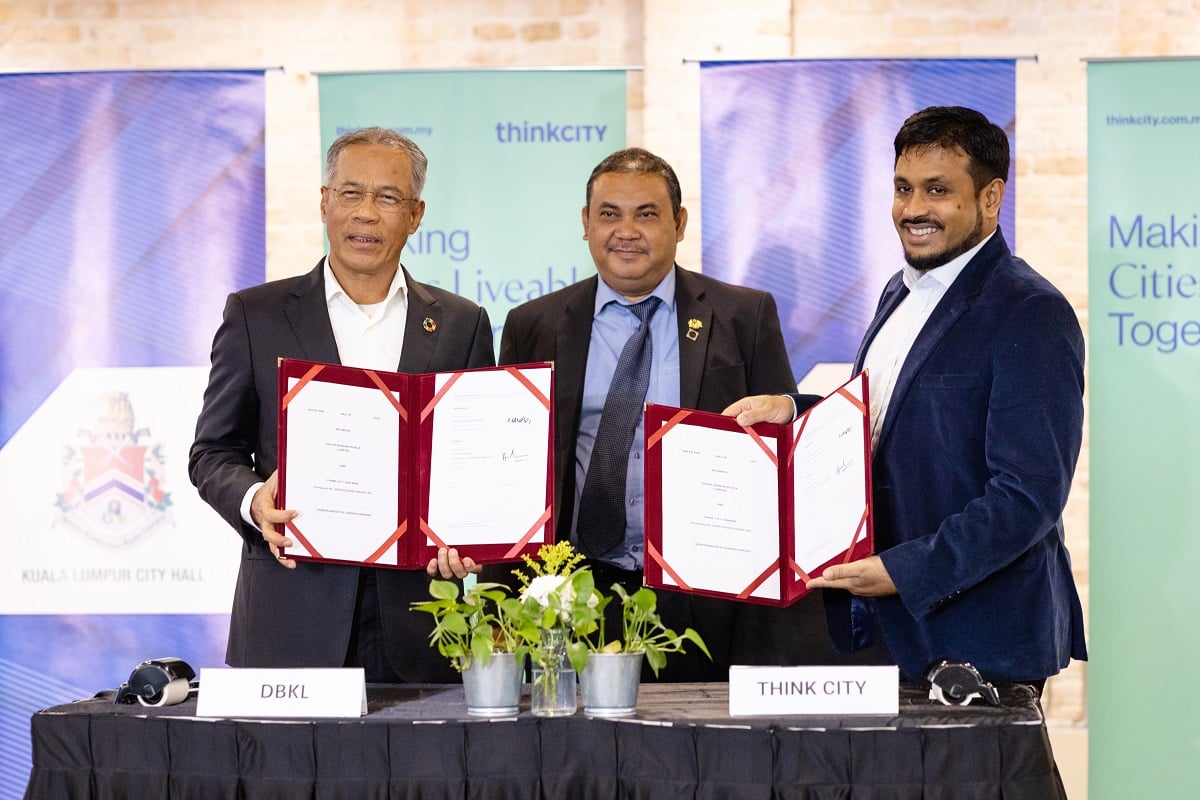
- The MOU aims to escalate efforts in pooling together ideas, resources and ecosystem partners to do more in making the city liveable, sustainable and prosperous, together.
- The announced partnership hopes to be a key platform for communities and stakeholders to contribute in showcasing the role of the city as a hub of creativity, capable of designing joint innovative solutions to urban challenges, increasing social equity, and generating new opportunities.
KUALA LUMPUR (Feb 9): Kuala Lumpur City Hall (DBKL) and Think City, an impact organisation to create more sustainable and equitable places, signed its third memorandum of understanding (MOU) on Feb 8 to accelerate their collaboration in rejuvenating Downtown Kuala Lumpur as a creative and cultural district.
The MOU aims to escalate efforts in pooling together ideas, resources and ecosystem partners to do more in making the city liveable, sustainable and prosperous, together.
It was signed by the Mayor of Kuala Lumpur Datuk Seri Mahadi Che Ngah and Think City’s managing director Hamdan Abdul Majeed, duly witnessed by the prime minister’s political secretary Azman Abidin.
DBKL’s Mahadi said: “The revitalisation of Downtown Kuala Lumpur is pertinent in making it a city that is relevant in a changing world. A world class city is more than just skyscrapers and huge commercial districts. A city must be equitable for all levels of society that enables it to be liveable; that means effective resilience interventions for the B40 communities, ramping up urban greening efforts, effective public transport facilities, strategies to manage climate change and its effect on the city, and bolstering rejuvenation efforts in city centres and heritage cores as key sites to drive the creative and cultural economy.”
In partnership with the Ministry of Tourism, Arts and Culture, National Heritage Department and Yayasan Hasanah, DBKL and Think City will continue to spearhead the realisation of Downtown Kuala Lumpur.
Think City’s Hamdan said: “Taking [the] lead from other urban creative and cultural hubs from around the world such as Bilbao and Barcelona in Spain, Sharjah in UAE, New Delhi in India, West Kowloon in Hong Kong, and Bras Basah in Singapore, creative and cultural districts have huge potential in making significant contributions to the national economy.”
He added: “Kuala Lumpur, especially its historic core in the city centre, that is already rich in tangible and intangible cultural assets, is well primed to become Malaysia’s first creative and cultural district.
“With Think City’s expertise in placemaking and strengthening culture-based economies, and with our strategic partnership with DBKL, we can achieve the vision of creating inclusive, authentic, and viable creative and cultural places within Downtown Kuala Lumpur that knit together the historic fabric to enhance the city’s liveability and visitor appeal.”
The announced partnership hopes to be a key platform for communities and stakeholders to contribute in showcasing the role of the city as a hub of creativity, capable of designing joint innovative solutions to urban challenges, increasing social equity, and generating new opportunities.
To date, the eight-year partnership demonstrates the positive work done by both DBKL and Think City through the rollout of more than 165 projects and 120 cultural events, workshops and engagements that includes laneway improvement programme, adaptive reuse, green transformation, and space activation, amongst others.
This approach is part of the recommendation from the Kuala Lumpur KLCCD Strategic Master Plan, a plan for the development and revitalisation of the cultural and creative industries in Kuala Lumpur. The goal of the plan is to create a vibrant and sustainable district in the city that will attract both local and international visitors, and to foster the growth of the creative and cultural industries in the region.
The master plan includes several key elements such as the development of cultural and creative spaces and facilities, the promotion of cultural and creative activities and events, and the support of local artists and creative professionals via job creation and income generation.
The plan also aims to create better connectivity between the cultural and creative district, the city centre and the surrounding areas, and it was developed to boost the economy and cultural tourism in Kuala Lumpur.
Together with the other programmes that have been drawn up such as the use of electric buses in Kuala Lumpur, Wangsa Maju as a pilot low-carbon city, additional installation of closed-circuit cameras (CCTV) in Kuala Lumpur and Putrajaya as well as the installation of WiFi in people’s housing, initiatives under the MOU signing can complement the government’s efforts to turn federal territories into smart cities by 2030.
The event also witnessed a recognition ceremony of beneficiaries of the second cycle of the Downtown Kuala Lumpur Grants Programme. Twelve beneficiaries, which benefited from the grants programmes on a co-investment basis, were announced at the event. The projects that will be funded range from walking and food tours by migrants and refugees, enhancement of performance space, greening transformation, film workshops and so on.





